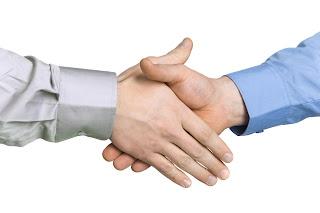Around the world, we smile, hug and kiss, shake hands or bow when we meet. Our arms, bodies, voices and faces all have a role to play in meeting and greeting. How strange that we behave so differently, depending where we live.
 |
| Leloft1911 dreamstime stock images |
It's easy to undermine our communication messages if we don't take care. For example, Mary thinks hugs are warm and cosy. She throws her arms round someone when she's pleased to see them, because she loves them, or maybe wants to comfort
them. Sadly, though, as a serial
hugger she doesn't always realise when the huggee is uncomfortable.
When she hugged Diane, her cousin stood still and stiff, waiting awkwardly until she finished. It wasn't because she doesn't like Mary. It's just that people don’t behave like
that where she comes from. She'd have preferred a simple smile.
Differences
Learn a little about the culture of the person you greet.
The Chinese, says blogger Hsin-Yi,
don’t hug. They prefer to nod and smile, even when greeting an old and close
friend after years of absence. Even fond mothers don’t hug their daughters, but show their love
in practical ways, like in the food they cook.
Kisses
In South America, on the other hand, hugging’s just not quite enough. Warm and friendly, Brasilians and Argentinians
like to plant a couple of warm kisses on your cheek, along with a hug and a pat
on the back. Men kiss men there, so northern
Europeans may have to deliver something more than their usual handshake, brief eye
contact or (very) restrained hug.
Technique
In other parts of Europe, the French and Belgians kiss once,
twice or three times on the cheek, depending on familiarity or even the part of the country. Walk into a room here and you’ll find
yourself passing from one person to the next, kissing each cheek separately.
Helpful
hint: try putting your left cheek forward first when you kiss to avoid untidy nose-bumps.
Restraint
Northern Europeans may prefer the sort of hug that makes sure
no body parts actually touch, or the “mwa-mwa” air kiss. Without the body contact, it’s often eye contact
and a warm smile that shows you care. You could try the politician's favourite handshake, where you clasp the other person’s hands
with both of yours, or grab their forearm at the same time, but beware of seeming controlling or condescending.
Maybe the Maoris in New Zealand manage things best with
their Hongi, where they touch noses and breathe together.
If you go to Japan, learn
to bow politely, or in India you may need to touch an older relative’s feet in order to show real respect.
Tips
Your best bet is to research the country you visit
carefully before you go, then spend some time people-watching when you arrive,
so you can see how most people behave.
More Communication blogs:
How To Make Friends When You're Shy
How To Be an Introvert
Verbal and Non Verbal Communication Skills: Ten Golden Rules
More Communication blogs:
How To Make Friends When You're Shy
How To Be an Introvert
Verbal and Non Verbal Communication Skills: Ten Golden Rules
No comments:
Post a Comment
What do you think? Leave your comment here: